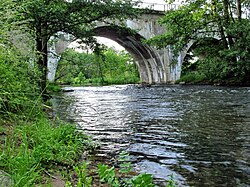Wda
This article needs additional citations for verification. (August 2009) |
| Wda | |
|---|---|
 | |
| Location | |
| Country | Poland |
| Physical characteristics | |
| Mouth | |
• location | Vistula |
• coordinates | 53°24′42″N 18°28′45″E / 53.4117°N 18.4792°E |
| Length | 198 km (123 mi) |
| Basin size | 2,325 km2 (898 sq mi) |
| Discharge | |
| • average | 6.52 m3/s (230 cu ft/s) |
| Basin features | |
| Progression | Vistula→ Baltic Sea |
The Wda (
The Wda begins its course at
Geography
The source of Wda is on
There is one river's canal below Wdzydze Lake. The river reaches Tleń, then flows across Wysoczyzna Świecka and ends in Wisła in Świecie on Dolina Fordońska.
Lakes
The Wdzydze Lake along with lakes Gołyń, Jeleń and Słupinek are called Morze Kaszubskie.[1] This lakes take a shape of the cross made of postglacial channels. Wdzydze Lake is dangerous for inexperienced canoeists during strong winds.
Towns
Flora and fauna
The Wda runs through many multispecies deciduous forests, in which contains diverse lichens. The river meanders also through riparian and alder forests. Rare mountain ash
History
The name “Wda” has been already used in the Middle Ages, but the river is also known as Czarna Woda. This name comes from dark brown colour of water caused by marshy banks, mineral molecules in water and sludge from tar factories in the 19th century. After World War I tourism started developing on Wda and about 40 years later Wda earned its title of The Queen of The Rivers of Kociew and The Beauty of The Land of Kociew.[2]
Hydroelectric power stations
On the Wda's route are three hydroelectric power stations located in
. In this area canoeists need to portage their canoes to the further part of the river.Attractions
Along the route of Wda some attractions can be found. First of them is a 19th-century Neogothic church in
See also
- Rivers of Poland
References
- ^ "Morze Kaszubskie". Archived from the original on 2011-08-29. Retrieved 2012-01-15.
- ^ "Kociewie :: KSI :: Kociewie - witamy!". Archived from the original on 2012-01-12. Retrieved 2012-01-15.
- ^ "Zaloguj się - Kaszuby.Org". www.kaszuby.org.
Sources
- http://visitkujawsko-pomorskie.pl/rzeka-wda,178,2,1109.html
- http://www.splywy.pl/wda/wda_dok.htm
- Galiński Z., Przewodnik dla kajakarzy. Wda, Pascal, 2003.

